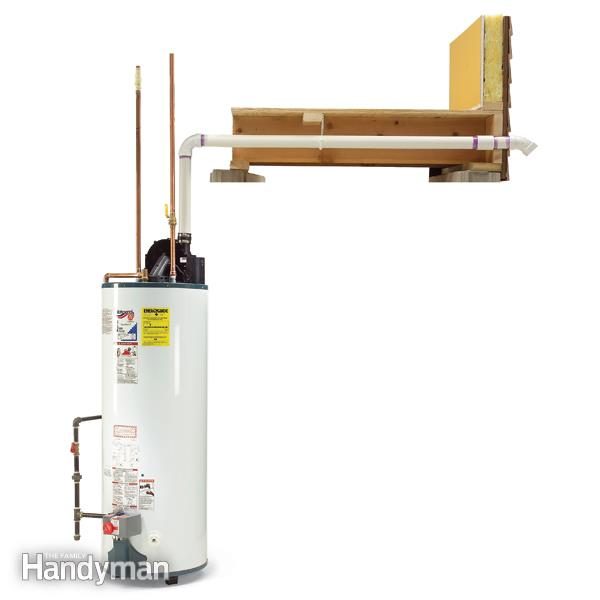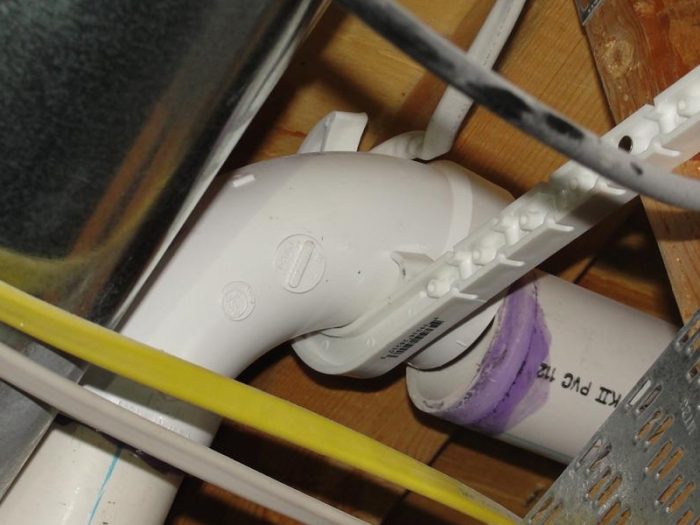Powervent water heaters have become the standard for new construction homes here in Minnesota, but are they really that great? As I mentioned in my last blog post about natural draft water heaters, a powervent water heater is equipped with a built-in fan that pushes the exhaust gas out of the vent with a powered fan. As far as I know, it’s impossible for these appliances to backdraft. If the fan doesn’t exhaust, the water heater won’t light.
The image below of an installed powervent water heater is courtesy of the fine folks at The Family Handyman.
Benefits of a powervent water heater
As you might imagine, the main benefit of a powervent water heater is that there is no potential to backdraft. This doesn’t completely eliminate the possibility of a carbon monoxide problem caused by the water heater, but it definitely lowers the potential. The two ways that carbon monoxide could still get into the home with a powervent would be from a disconnected or leaking vent, or from a vent that is terminated too close to an air intake at the exterior. And yes, I’ve seen both. The photo below was from a new-construction inspection where one of the vent sections simply hadn’t been glued.
Another benefit offered by a powervent water heater is lower energy consumption. They’re more efficient, so they use less fuel… but not a lot less. The Energy Center of Wisconsin estimated powervent water heaters to save about $20 – $25 per year over a traditional water heater, but they were basing that on fuel costing $1 / therm. See that study here. Here in MN, the cost of natural gas is about half of that, so the annual savings would be about $10 – $13 per year. Again, per year.
Because they don’t use a vent that runs up through the middle of the house, powervent water heaters give a lot more flexibility when it comes to locating the unit. Manufacturers allow for fairly long runs on the vent, making it possible to put the unit just about anywhere that’s convenient.
Powervent water heaters also recover hot water faster, but it’s not a huge difference.
Drawbacks to powervent water heaters
Noisy: They’re noisy when they’re new, and they don’t get better over time. Check out the video clip below showing a new powervent water heater starting up.
Electricity: Powervent water heaters need to be plugged into an outlet to operate. That often means an electrical outlet will need to be added as part of a replacement install, which can significantly add to the cost. That also means that if the power goes out or a GFCI device gets tripped, the water heater will stop working.
Electricity: Yes, I said it again. This means an electronic control that could go bad, but more likely a fan motor that will go bad. Once the fan motor goes bad, the water heater won’t run. Once this happens, many homeowners simply choose to replace the water heater itself.
More Money: Powervent water heaters cost about 75% more than their natural draft counterparts. Besides the additional cost for the unit itself, it’s a lot more work to upgrade to a powervent water heater than to simply swap out a traditional water heater with the same type. I made a short video a few weeks ago showing the swap-out process here: water heater replacement video.
Shorter warranty: traditional natural draft water heaters come with 6-year, 9-year, or 12-year warranties. If there’s a powervent water heater with a warranty longer than 6 years, the manufacturers have all done a good job of making sure I can’t find them.
What about high-efficiency direct-vent water heaters?
These are water heaters with a two-pipe system that get powervented. They’re hideously expensive and not worth the money, in most cases. They cost close to $2k for the unit alone and the savings aren’t much. If the price of gas triples… they still won’t be worth it. The only situation that I can think of where it would make sense to install a high-efficiency direct-vent water heater would be in a case where nothing else is allowed by code. Code requirements will allow the installation of a direct-vent appliance pretty much anywhere; even in a bedroom or bathroom. See section 303.3 of the Minnesota State Fuel Gas Code for more details on appliance locations.
Conclusion
Should your next water heater be a powervent? You’ll need to weigh the pros and cons. Without a doubt, the largest benefit is added safety, and the largest drawback is the added cost.



Jon Errickson
February 21, 2017, 7:46 am
Do powervented and natural draft water heaters have the same service life, or does one typically last longer than the other?
Reuben Saltzman
February 21, 2017, 10:59 am
Hi Jon,
Given the fact that powervent water heater manufacturers only offer 6-year warranties, my assumption is that they don’t last as long, but I haven’t seen any published data supporting my assumption.
Erik
February 21, 2017, 1:00 pm
Hello,
Have you ever seen direct-vent, sealed-combustion gas water heaters used in MN? They seem to solve the problem of the potential for back draft without the noise or need for electricity of a power vent. When my atmospherically vented one needs replacement, I would like to use one because it is located near a room in my basement that I plan on finishing and partly using as a home theater (power vent noise would be highly undesirable).
Seem to be more popular in Canada, but I believe I have seen them on the big orange box website as well as here:
http://www.supplyhouse.com/AO-Smith-GDV-50-50-Gallon-ProMax-Direct-Vent-Residential-Water-Heater?gclid=COWJzY_vodICFYO4wAodUsQBWw
Reuben Saltzman
February 21, 2017, 2:21 pm
Hi Erik,
Yes, I’ve seen a handful of those, but I didn’t mention them because they’re so uncommon. The problem with those is that they need to be located against an exterior wall, as the venting limitations are quite strict. Other than that, I don’t understand why they’re not used more commonly.
Erik
February 21, 2017, 4:47 pm
Me either… outside wall not a problem in my application. Hard to even find someone who knows what they are. May up installing it myself (with a permit, of course). Thanks!
Jim Erdman
February 21, 2017, 4:54 pm
Over 10 years ago I bought a used LP power vent water heater from people who had installed it before they got natural gas in their neighborhood, and it was less than 2 years old. I got a good deal on it of course, but I wanted a power vent unit because our old gas water heater was vented into the same chimney as our wood furnace, and I didn’t want to put in a new vent through 2 stories of the house and the attic. Running some PVC pipe and drilling through the wall was much easier and cheaper. We had to replace the electronic control box over 6 years ago but have had no other problems. It does plug into an ordinary 120 volt receptacle, which makes it simple to put the water heater on a timer.
Chris brown
February 25, 2017, 6:02 pm
Is there any information about the additional cost of exhausting the heated room air along with the exhaust gasses?
Reuben Saltzman
March 6, 2017, 5:46 am
@Chris –
No, I don’t have any information on that. I’m sure it’ll make a difference, but if you’re comparing a powervent to a traditional water heater, I don’t think it’ll be a big difference.
Randy Birzer
March 2, 2017, 7:16 pm
It there a special PVC vent pipe like High Efficiency gas furnaces? Or will any schedule 40 due?
Reuben Saltzman
March 6, 2017, 5:45 am
Hi Randy,
Manufacturers don’t have any special requirements for the venting. They allow any schedule 40.
Walstead Robert
March 5, 2017, 4:24 pm
Question: Is it possible that the fact that the power vent water heater uses more conditioned air from the house will offset the energy savings because that conditioned air is going to have to be replaced either heat or air conditioning?
Reuben Saltzman
March 6, 2017, 5:49 am
Hi Robert,
As I know you know, a traditional gas water heater also uses a lot of conditioned air from the house. You’ll have primary combustion air, secondary dilution air, and you’ll have all of the air that rises out of the vent all day long, even when the water heater isn’t running. Powervent water heaters don’t have that loss, so I suspect the difference between the two appliances is a wash.